Few creatures on Earth capture the imagination quite like the chameleon. With their independently swiveling eyes, lightning-fast tongues, and legendary ability to shift colors, these reptiles seem to belong to a realm of pure fantasy. Yet, they are very real, thriving across diverse landscapes and showcasing some of nature’s most extraordinary adaptations. Join us on a journey into the captivating world of chameleons, exploring their biology, behavior, and the vital role they play in our planet’s ecosystems.
The Masters of Disguise: What is a Chameleon?
Chameleons are a distinctive and highly specialized clade of Old World lizards, belonging to the family Chamaeleonidae. Their name, derived from Greek, literally means “earth lion” or “ground lion,” a curious moniker for creatures often found clinging to branches. These reptiles are renowned for several unique anatomical features that set them apart from other lizards, making them truly iconic.
Their most famous trait, color change, is often misunderstood as solely a camouflage mechanism. While chameleons certainly use color to blend seamlessly with their surroundings, their skin pigmentation is also a crucial tool for communication, thermoregulation, and displaying mood. Beyond their chromatic prowess, chameleons possess a suite of other remarkable adaptations, from their turret-like eyes to their projectile tongues, all contributing to their survival in a complex world.
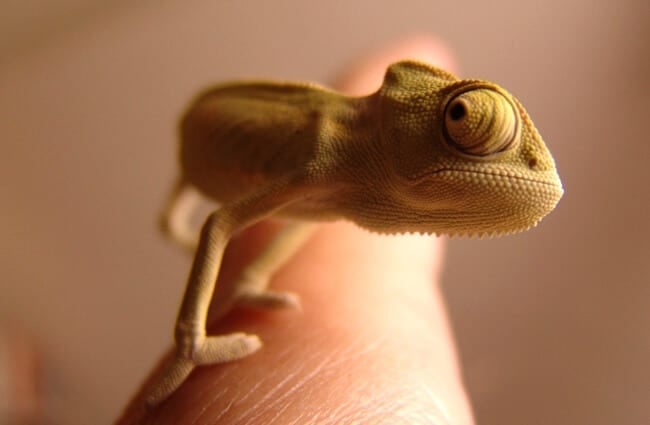
A World of Chameleons: Diversity and Distribution
The chameleon family is incredibly diverse, encompassing over 200 recognized species, each with its own unique characteristics and ecological niche. These fascinating reptiles are primarily arboreal, meaning they spend most of their lives in trees and shrubs, but some species are terrestrial, living among leaf litter on the forest floor.
Chameleon’s Habitat: Where They Roam
Chameleons are native to warm habitats, predominantly found in Africa and Madagascar, which is a biodiversity hotspot for these lizards, hosting roughly half of all known species. Their range also extends into parts of Southern Europe, mainland Asia, and even a few islands in the Indian Ocean. They occupy an astonishing variety of environments:
- Rainforests: Many species thrive in the humid, dense canopy of tropical rainforests, where abundant foliage provides both cover and hunting grounds.
- Savannas: Some chameleons are adapted to the drier, more open landscapes of savannas, often found in thorny bushes and acacia trees.
- Deserts and Semi-Deserts: Surprisingly, a few hardy species have evolved to survive in arid regions, demonstrating remarkable resilience to extreme temperatures and water scarcity.
- Mountains: Certain species inhabit cooler, higher altitude environments, showcasing their adaptability to varying climatic conditions.
An animal lover aiming to find a chameleon in the wild should focus on these regions, particularly Madagascar and sub-Saharan Africa. Look for them in dense vegetation, often on branches or among leaves, especially during the day when they are most active. Their camouflage makes them incredibly difficult to spot, so patience and a keen eye for subtle movement are essential.
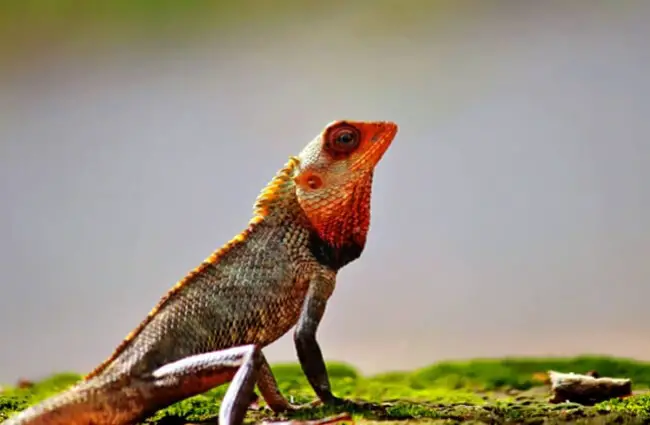
Chameleon’s Evolution History: An Ancient Lineage
The evolutionary history of chameleons is a subject of ongoing scientific inquiry, but fossil evidence suggests they are an ancient group, with their origins potentially tracing back to the Paleocene epoch, over 60 million years ago. Genetic studies indicate that chameleons likely originated in mainland Africa, with subsequent dispersal events leading to their colonization of Madagascar and other regions. The incredible diversity seen today is a testament to millions of years of adaptive radiation, where different species evolved to fill specific ecological niches, leading to a wide array of sizes, shapes, and color patterns.
The Chameleon’s Toolkit: Anatomy and Adaptations
The chameleon’s body is a marvel of natural engineering, packed with specialized features that make it an unparalleled hunter and survivor.
Eyes: Independent Vision and 360-Degree Awareness
Perhaps the most iconic feature of chameleons is their eyes. Each eye can move independently, swiveling like turrets, allowing the chameleon to scan its surroundings for prey and predators simultaneously. This grants them an almost 360-degree field of vision without moving their head. When a potential target is identified, both eyes can then converge, focusing on the object to provide precise binocular depth perception, crucial for their hunting strategy.
Tongue: The Lightning-Fast Projectile
The chameleon’s tongue is a biological wonder. It can be projected at incredible speeds, sometimes reaching 0 to 60 mph in a mere hundredth of a second, and can extend up to 1.5 to 2 times the length of the chameleon’s body. This ballistic tongue is tipped with a sticky, muscular pad that creates a powerful suction cup effect, allowing it to snatch insects and even small vertebrates with astonishing accuracy and force. The entire process, from launch to retraction, happens in fractions of a second, making escape nearly impossible for its prey.
Feet: The Perfect Grip
Chameleons possess zygodactylous feet, a unique arrangement where the toes are fused into opposing groups. On the front feet, two toes are fused on the inside and three on the outside, while on the hind feet, it’s the opposite: three toes fused on the inside and two on the outside. This pincer-like grip provides an incredibly secure hold on branches, allowing them to navigate their arboreal environment with remarkable stability, even in strong winds.
Tail: A Fifth Limb
Most chameleon species have a prehensile tail, which acts as a fifth limb. It can coil tightly around branches, providing additional support and balance, especially when reaching for prey or navigating precarious perches. This tail is a vital tool for arboreal locomotion and stability.

Skin: More Than Just Camouflage
The chameleon’s ability to change color is not magic, but a sophisticated biological process involving specialized cells called chromatophores. These cells contain different pigments and can expand or contract, revealing or concealing underlying layers of color. While camouflage is a primary function, allowing them to blend seamlessly with leaves, bark, or rocks, color change also serves other critical purposes:
- Communication: Chameleons use color displays to signal their mood, territorial intentions, and readiness to mate. Bright, vibrant colors often indicate aggression or courtship, while duller hues might signify submission or stress.
- Thermoregulation: By changing their skin color, chameleons can regulate their body temperature. Darker colors absorb more heat, helping them warm up in cooler conditions, while lighter colors reflect heat, preventing overheating in direct sunlight.
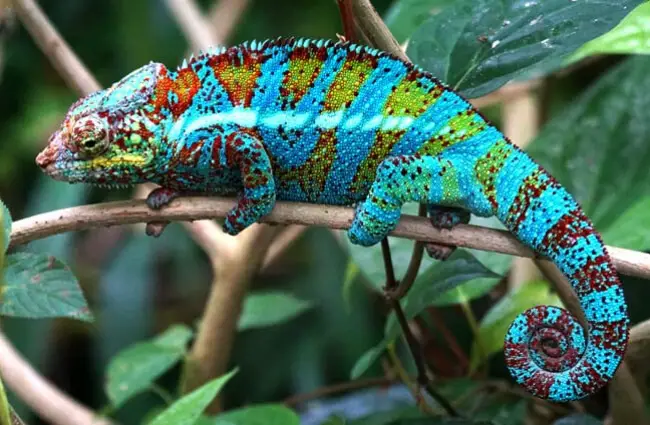
Life in the Wild: Behavior and Ecology
Chameleons are primarily diurnal, meaning they are active during the day. They are generally solitary creatures, coming together mainly for mating. Their slow, deliberate movements are part of their hunting strategy, allowing them to remain undetected by both prey and predators.
Chameleon’s Diet: The Insectivore’s Feast
Chameleons are almost exclusively insectivores, with their diet consisting mainly of a wide variety of insects and other invertebrates. Their hunting strategy is a masterclass in patience and precision:
- They remain perfectly still, often swaying gently to mimic leaves in the breeze.
- Their independently moving eyes constantly scan the environment.
- Once prey is spotted and targeted, both eyes lock on, and the chameleon slowly inches closer.
- With a sudden, explosive launch, the tongue shoots out, captures the unsuspecting insect, and retracts it back into the mouth in a blink.
Larger chameleon species may occasionally consume small vertebrates, such as other lizards, small birds, or even young rodents, but insects form the bulk of their diet.
Chameleon’s Contribution to Ecosystem and Interaction with Other Animals
As insectivorous predators, chameleons play a vital role in their ecosystems by helping to control insect populations. This contributes to the overall health and balance of their habitats, preventing overpopulation of certain insect species that could otherwise damage vegetation or spread diseases.
Their interactions with other animals are primarily those of predator and prey. While they are formidable hunters of insects, chameleons themselves are prey for a variety of animals, including:
- Birds of prey: Hawks, eagles, and other raptors are significant predators.
- Snakes: Many arboreal snake species will hunt chameleons.
- Larger lizards: Some larger lizard species may prey on smaller chameleons.
- Primates: Monkeys and other arboreal mammals can also be predators.
Their primary defense mechanisms against these predators are their exceptional camouflage and their ability to remain perfectly still. If detected, some chameleons may inflate their bodies, hiss, or even bite, though these are usually last resorts.
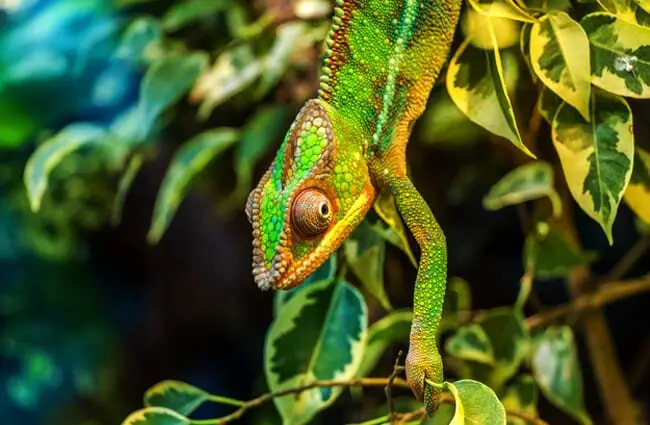
The Cycle of Life: Mating and Reproduction
Chameleon reproduction is a fascinating process, varying slightly between species but generally following a similar pattern of courtship, mating, and egg-laying.
Chameleon’s Mating and Reproduction Process
When a male chameleon encounters a female, he will typically initiate a courtship display involving elaborate color changes, head bobbing, and body posturing to impress her and signal his intentions. The female’s response, often through her own color changes, will indicate her receptivity or rejection. If receptive, mating occurs.
Most chameleon species are oviparous, meaning they lay eggs. After a gestation period, the female will descend from the trees to dig a burrow in the soil, where she deposits her clutch of eggs. The number of eggs varies greatly by species, ranging from a few to over a hundred. She then carefully covers the eggs, leaving them to incubate. The incubation period can last anywhere from a few months to over a year, depending on the species and environmental conditions like temperature and humidity.
A smaller number of chameleon species are ovoviviparous, meaning they give birth to live young. In these species, the eggs hatch internally, and the young emerge fully formed, bypassing the external egg stage. This adaptation is often found in species inhabiting cooler climates, where the mother’s body can provide a more stable incubation environment.
Once the eggs are laid or the young are born, there is typically no parental care. The hatchlings or newborns are entirely self-sufficient from birth, relying on their innate instincts for survival.
Chameleons and Us: Human Interaction and Conservation
Chameleons have long captivated human interest, influencing culture and facing challenges due to human activities.
Chameleon’s Contribution to Human Culture
In various cultures, chameleons are often seen as symbols of adaptability, change, and even wisdom. Their unique ability to change color has led to their association with transformation and illusion. In some African folklore, they are revered or seen as messengers, while in others, they might be associated with trickery due to their elusive nature. Their distinctive appearance has also made them popular subjects in art, literature, and modern media.
Chameleon’s Interaction with Humans: Challenges and Responsibilities
Unfortunately, human interaction with chameleons is not always positive. The pet trade, both legal and illegal, poses a significant threat to many wild chameleon populations. Habitat destruction, driven by deforestation for agriculture, logging, and urban development, is another major factor contributing to their decline. Climate change also presents a long-term threat, altering their delicate habitats and affecting their reproductive cycles.
Many chameleon species are now listed as vulnerable, endangered, or critically endangered by the IUCN (International Union for Conservation of Nature). Conservation efforts focus on protecting their habitats, regulating the pet trade, and raising public awareness about their plight.
Encountering a Chameleon in the Wild: What to Do
For a hiker who encounters a chameleon in the wild, the best course of action is simple: observe from a respectful distance and do not disturb the animal. Chameleons are sensitive to stress, and handling them can cause them harm. Appreciate their beauty and unique adaptations, perhaps take a photograph, but leave them undisturbed in their natural environment. Never attempt to capture or remove a chameleon from the wild, as this is illegal in many places and detrimental to the animal’s well-being and wild populations.
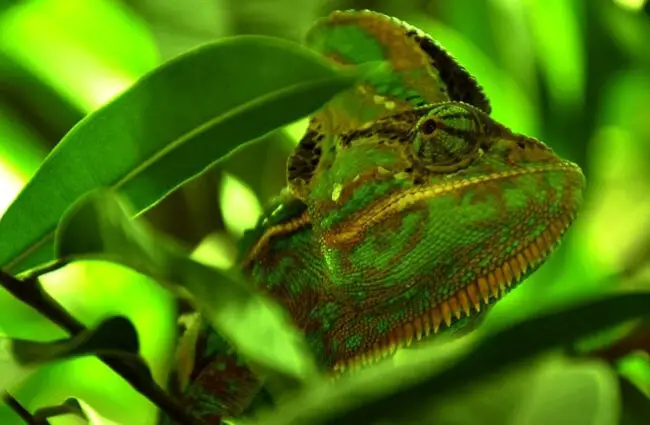
Caring for a Chameleon: A Zookeeper’s Guide
Caring for chameleons in captivity, whether in a zoo or as a responsible pet owner, requires specialized knowledge and dedication to replicate their complex environmental needs. Aspiring zoologists and zookeepers must understand these requirements to ensure the well-being of these delicate reptiles.
Habitat Setup: The Enclosure
A chameleon enclosure, often called a vivarium or terrarium, must be spacious and well-ventilated. Screen enclosures are generally preferred over glass tanks for most species, as they provide superior airflow, which is crucial for preventing respiratory infections. The enclosure should be tall rather than wide, reflecting their arboreal nature.
- Branches and Foliage: Provide plenty of climbing opportunities with branches of varying diameters and live, non-toxic plants (e.g., Ficus, Pothos, Schefflera) for cover, security, and humidity.
- Substrate: A simple substrate like paper towels or coco fiber is often used, making cleaning easier and reducing the risk of impaction.
Temperature and Humidity
Maintaining the correct thermal and humidity gradients is paramount:
- Temperature: A basking spot with temperatures typically ranging from 85-95°F (29-35°C) should be provided, along with a cooler ambient temperature gradient of 70-80°F (21-27°C). Nighttime temperatures can drop slightly.
- Humidity: Most chameleons require moderate to high humidity, often achieved through misting the enclosure multiple times a day or using a fogger/mister. Specific humidity levels vary by species.
Lighting: Essential for Health
Chameleons require two types of lighting:
- UVB Lighting: Essential for vitamin D3 synthesis, which allows them to absorb calcium. A high-quality UVB bulb should be provided for 10-12 hours daily and replaced every 6-12 months, as UVB output degrades over time.
- Heat Lamp: A basking lamp provides the necessary heat for thermoregulation.
Chameleon’s Diet in Captivity
A varied diet of gut-loaded insects is crucial. Gut-loading means feeding the feeder insects a nutritious diet before offering them to the chameleon. Common feeder insects include:
- Crickets
- Dubia roaches
- Mealworms (in moderation)
- Superworms (in moderation)
- Silkworms
- Hornworms
Insects should be dusted with a calcium supplement (without D3) at most feedings and a multivitamin supplement (with D3) a few times a month, according to veterinary recommendations. Water should be provided by misting, as chameleons rarely drink from standing water; they prefer to lick droplets off leaves.
What to Avoid
- Stress: Chameleons are easily stressed. Avoid frequent handling, loud noises, and sudden movements around their enclosure.
- Improper Diet: Feeding insects that are too large, not gut-loaded, or lacking proper supplementation can lead to nutritional deficiencies like Metabolic Bone Disease.
- Stagnant Air: Poor ventilation can lead to respiratory issues.
- Incorrect Temperatures/Humidity: These can cause a range of health problems, from dehydration to fungal infections.
- Cohabitation: Chameleons are solitary; housing multiple individuals together often leads to stress, aggression, and injury.
Fascinating Facts About Chameleons
Here is a huge list of interesting facts about chameleons that highlight their unique biology and behavior:
- Some chameleon species are among the smallest reptiles in the world, with adults measuring just over an inch long.
- The largest chameleon, Parson’s chameleon, can grow up to 27 inches (69 cm) in length.
- Chameleons do not have external ears, but they can detect sounds.
- Their eyelids are fused, leaving only a small pinhole for vision, which helps protect their eyes.
- The tongue of a chameleon can accelerate from 0 to 60 mph in a hundredth of a second, exerting a force equivalent to 26 times the force of gravity.
- They have a parietal eye, or “third eye,” on the top of their head, which is sensitive to light and helps regulate their circadian rhythm and hormone production.
- Chameleons shed their skin in patches, not in one complete piece like many snakes.
- Despite their slow, deliberate movements, some chameleons can run surprisingly fast when threatened.
- Many species have elaborate crests, horns, or casque-like structures on their heads, which are used for display and species identification.
- The color changes are not voluntary in the way we might think; they are largely controlled by the autonomic nervous system in response to environmental cues and physiological states.
- Chameleons are often territorial, especially males, and will display aggressive color patterns and postures to ward off rivals.
- Their unique foot structure, zygodactyly, is also seen in parrots and some woodpeckers.
- Some chameleons can live for over a decade in captivity with proper care, though wild lifespans are often shorter.
From their ancient origins to their intricate adaptations, chameleons truly are living wonders. Their existence reminds us of the incredible diversity of life on Earth and the importance of preserving every unique thread in the tapestry of nature. By understanding and appreciating these remarkable reptiles, we can all contribute to their continued survival for generations to come.

![Red Angus Closeup of a beautiful Red Angus cowPhoto by: U.S. Department of Agriculture [pubic domain]https://creativecommons.org/licenses/by/2.0/](https://animals.net/wp-content/uploads/2020/03/Red-Angus-4-238x178.jpg)




![Red Angus Closeup of a beautiful Red Angus cowPhoto by: U.S. Department of Agriculture [pubic domain]https://creativecommons.org/licenses/by/2.0/](https://animals.net/wp-content/uploads/2020/03/Red-Angus-4-100x75.jpg)

